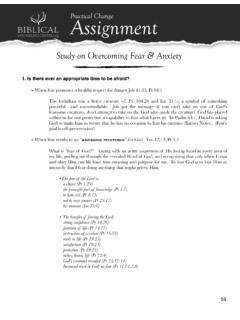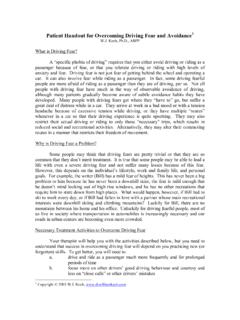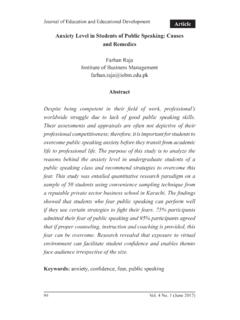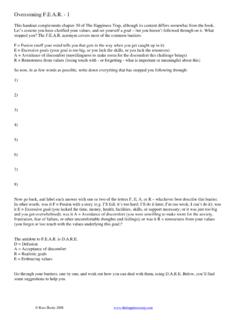Transcription of Overcoming the Five Dysfunctions of a Team
1 Overcoming the Five Dysfunctions of a team Leadership Development Luncheon February 11, 2015 Rudy Greg Trejo, Rudy Trejo, Assistant Director of Student Activities for Student Government Leadership & ASG Advisor Forth Year at Arkansas Oversees Student Government Chair, SEC Student Government Advisors Board Five Dysfunctions Overview Five Dysfunctions Overview Thank You for Taking Up The Responsibility of Leadership. Five Dysfunctions Purpose The purpose of this model is simple: to provide managers, team leaders, consultants, student leaders, and others with a practical tool for helping implement successful strategies in ensuring maximum growth and achievement. Five Dysfunctions Overview Five Dysfunctions Overview Absence of trust unwilling to be vulnerable within the group.
2 Members of teams with an absence of 1. Conceal their weaknesses and mistakes from one another. 2. Hesitate to ask for help or provide constructive feedback. 3. Hesitate to offer help outside their own areas of responsibility. 4. Jump to conclusions about the intentions and aptitudes of others without attempting to clarify them. 5. Fails to recognize and tap into one another s skills and experiences. 6. Waste time and energy managing their behaviors for effect. 7. Hold grudges. 8. Dread meetings and find reasons to avoid spending time together. Absence of Trust Five Dysfunctions Overview Members of great teams trust one another on a fundamental, emotional level, and they are comfortable being vulnerable with each other about their weaknesses, mistakes, fears, and behaviors.
3 They get straight to the point because they can be completely open with one another, without filters. Trust is the fundamental foundation of teamwork, building trust takes time, and it I s never complete, it must be maintained. Absence of Trust Five Dysfunctions Overview Five Dysfunctions Overview Fear of conflict seeking artificial harmony over constructive passionate debate. Members of teams that fear conflict: 1. Have boring meetings. 2. Create environments where back-channel politics and personal attacks thrive. 3. Ignore controversial topics that are critical to team success. 4. Fail to tap into all the opinions and perspectives of team members. 5. Waste time and energy with posturing and interpersonal risk management. Fear of Conflict Five Dysfunctions Overview Teams that trust one another are not afraid to engage in passionate dialogue around issues and decisions that are key to the organization s success.
4 They do not hesitate to disagree with, challenge, and question one another, all in the spirit of finding the best answers, discovering the truth, and making great decisions. Good conflict among team members requires trust, even among the best teams, conflict can be uncomfortable, it must be discussed what process is. Fear of Conflict Five Dysfunctions Overview Five Dysfunctions Overview Lack of commitment feigning buy-in for group decisions creates ambiguity throughout the organization Members of teams that fail to commit: 1. Create ambiguity among the team about direction and priority. 2. Watches windows of opportunity close due to excessive analysis and unnecessary delay. 3. Breeds lack of confidence and fear of failure. 4. Revisits discussions and decisions again and again.
5 5. Encourages second-guessing among team members. Lack of Commitment Five Dysfunctions Overview Teams that engage in unfiltered conflict are able to achieve genuine buy-in around important decisions, even when various members of the team initially disagree. That s because they ensure that all opinions and ideas are put on the table and considered, giving confidence to team members that no stone has been left unturned. Commitment requires clarity and buy-in, but does not require consensus. Lack of Commitment Five Dysfunctions Overview Five Dysfunctions Overview Avoidance of accountability ducking the responsibility to call peers on counterproductive behavior which sets low standards Members of teams that avoids accountability: 1. Creates resentment among team members who have different standards of performance.
6 2. Encourages mediocrity. 3. Misses deadlines and key deliverables. 4. Places an undue burden on the team leader as the sole source of discipline. Avoidance of Accountability Five Dysfunctions Overview Teams that commit to decisions and standards of performance do not hesitate to hold one another accountable for adhering to those decisions and standards. What is more, they don t rely on the team leader as the primary source of accountability, they go directly to their peers. Accountability occurs directly among peers, and the leader must be willing to confront friends and peers. Accountability should occur frequently during meetings and following up on goals. Avoidance of Accountability Five Dysfunctions Overview Five Dysfunctions Overview Inattention to results focusing on personal success, status and ego before team success Members of teams that are not focused on results: 1.
7 Stagnates/fails to grow. 2. Rarely defeats competitors. 3. Loses achievement-oriented student leaders. 4. Encourages team members to focus on their own intentions and personal goals. 5. Is easily distracted. Inattention to Results Five Dysfunctions Overview Teams that trust one another, engage in conflict, commit to decisions, and hold one another accountable are very likely to set aside their individual needs and agendas and focus almost exclusively on what is best of the team . They do not give in to the temptations to place their organization, personal aspirations, or ego-driven status ahead of the collective results that define team success. A great team will accomplish the goals it set out by prioritizing, staying focus, and putting individual needs under group goals. Inattention to Results Five Dysfunctions Overview ENGAGE SERVE GROW Five Dysfunctions Overview More Information: The Five Dysfunctions of a team By, Patrick Lencioni FINISH WHAT WE STARTED Overcoming the Five Dysfunctions of a team Leadership Development Luncheon February 11, 2015









